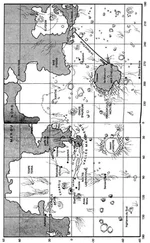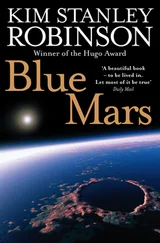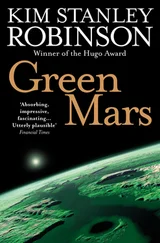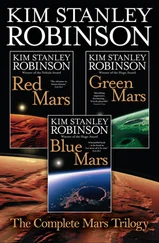Kim Robinson - Blue Mars
Здесь есть возможность читать онлайн «Kim Robinson - Blue Mars» — ознакомительный отрывок электронной книги совершенно бесплатно, а после прочтения отрывка купить полную версию. В некоторых случаях можно слушать аудио, скачать через торрент в формате fb2 и присутствует краткое содержание. Год выпуска: 1996, ISBN: 1996, Издательство: Spectra/Bantam Dell/Random House, Жанр: Космическая фантастика, на английском языке. Описание произведения, (предисловие) а так же отзывы посетителей доступны на портале библиотеки ЛибКат.
- Название:Blue Mars
- Автор:
- Издательство:Spectra/Bantam Dell/Random House
- Жанр:
- Год:1996
- ISBN:0-553-10144-7
- Рейтинг книги:3 / 5. Голосов: 1
-
Избранное:Добавить в избранное
- Отзывы:
-
Ваша оценка:
- 60
- 1
- 2
- 3
- 4
- 5
Blue Mars: краткое содержание, описание и аннотация
Предлагаем к чтению аннотацию, описание, краткое содержание или предисловие (зависит от того, что написал сам автор книги «Blue Mars»). Если вы не нашли необходимую информацию о книге — напишите в комментариях, мы постараемся отыскать её.
Green Mars
The Martian Chronicles
Dune
Piblishers Weekly st
Blue Mars — читать онлайн ознакомительный отрывок
Ниже представлен текст книги, разбитый по страницам. Система сохранения места последней прочитанной страницы, позволяет с удобством читать онлайн бесплатно книгу «Blue Mars», без необходимости каждый раз заново искать на чём Вы остановились. Поставьте закладку, и сможете в любой момент перейти на страницу, на которой закончили чтение.
Интервал:
Закладка:
Of course from this wonderful vantage point she now had, the horizontal stratification of the interior walls added a lot of irregular detail, rust and black and chocolate and umber bands indicating variations in the composition of the lava deposits; and some bands were harder than those above and below, so that there were many arcuate balconies lining the wall at different elevations — isolated curving benches, perched on the side of the immense rock throat, most never visited. And the floor so flat. The subsidence of the volcano’s magma chamber, located some 160 kilometers below the mountain, had to have been unusually consistent; it had dropped in the same place every time. Ann wondered if it had been determined yet why that had been; if the magma chamber had been younger than the other big volcanoes, or smaller, or the lava more homogenous… Probably someone had investigated the phenomenon; no doubt she could look it up on the wrist. She tapped out the code for the Journal of Analogical Studies, typed in Pavonis: “Evidence of Strombolian Explosive Activity Found in West Tharsis Clasts.” “Radial Ridges in Caldera and Concentric Graben Outside the Rim Suggest Late Subsidence of the Summit.” She had just crossed some of those graben. “Release of Juvenile Volatiles into Atmosphere Calculated by Radiometric Dating of Lastflow Mafics.”
She clicked off the wristpad. She no longer kept up with all the latest areology, she hadn’t for years. Even reading the abstracts would have taken far more time than she had. And of course a lot of areology had been badly compromised by the terraforming project. Scientists working for the metanats had concentrated on resource exploration and evaluation, and had found signs of ancient oceans, of the early warm wet atmosphere, possibly even of ancient life; on the other hand radical Red scientists had warned of increased seismic activity, rapid subsidence, mass wasting, and the disappearance of even a single surface sample left in its primal condition. Political stress had skewed nearly everything written about Mars in the past hundred years. The Journal was the only publication Ann knew of which tried to publish papers delimiting their inquiries very strictly to reporting areology in the pure sense, concentrating on what had happened in the five billion years of solitude; it was the only publication Ann still read, or at least glanced at, looking through the titles and some of the abstracts, and the editorial material at the front; once or twice she had even sent in a letter concerning some detail or other, which they had printed without fanfare. Published by the university in Sabishii, the Journal was peer-reviewed by like-minded areologists, and the articles were rigorous, well researched, and with no obvious political point to their conclusions; they were simply science. The Journal’s editorials advocated what had to be called a Red position, but only in the most limited sense, in that they argued for the preservation of the primal landscape so that studies could be carried on without having to deal with gross contaminations. This had been Ann’s position from the very start, and it was still where she felt most comfortable; she had moved from that scientific position into political activism only because it had been forced on her by the situation. This was true for a lot of areologists now supporting the Reds. They were her natural peer group, really — the people she understood, and with whom she sympathized.
But they were few; she could almost name them individually. The regular contributors to the Journal, more or less. As for the rest of the Reds, the Kakaze and the other radicals, what they advocated was a kind of metaphysical position, a cult — they were religious fanatics, the equivalent of Hi-roko’s greens, members of some kind of rock-worshiping sect. Ann had very little in common with them, when it came down to it; they formulated their redness from a completely different worldview.
And given that there was that kind of fractionization among the Reds themselves, what then could one say about the Martian independence movement as a whole? Well. They were going to fall out. It was happening already.
Ann sat down carefully on the edge of the final bench. A good view. It appeared there was a station of some kind down there on the caldera floor, though from five thousand meters up, it was hard to be sure. Even the ruins of old Sheffield were scarcely visible — ah — there they were, on the floor under the new town, a tiny pile of rubble with some straight lines and plane surfaces in it. Faint vertical scorings on the wall above might have been caused by fall of the city in ‘61. It was hard to say.
The tented settlements still on the rim were like toy villages in paperweights. Sheffield with its skyline, the low warehouses across from her to the east, Lastflow, the various smaller tents all around the rim… many of them had merged, to become a kind of greater Sheffield, covering almost 180 degrees of the rim, from Lastflow around to the southwest, where pistes followed the fallen cable down the long slope of west Tharsis to Amazonis Planitia. All the towns and stations would always be tented, because at twenty-seven kilometers high the air would always be a tenth as thick as it was at the datum — or sea level, one could now call it. Meaning the atmosphere up here was still only thirty or forty millibars thick.
Tent cities forever; but with the cable (she could not see it) spearing Sheffield, development would certainly continue, until they had built a tent city entirely ringing the caldera, looking down into it. No doubt they would then tent the caldera itself, and occupy the round floor — add about 1,500 square kilometers to the city, though it was a question who would want to live at the bottom of such a hole, like living at the bottom of a mohole, rock walls rising up around you as if you were in some circular roofless cathedral … perhaps it would appeal to some. The Bogdanovists had lived in moholes for years, after all. Grow forests, build climber’s huts or rather millionaires’ penthouses on the arcuate balcony ledges, cut staircases into the sides of the rock, install glass elevators that took all day to go up or down … rooftops, row houses, skyscrapers reaching up toward the rim, heliports on their flat round roofs, pistes, flying freeways … oh yes, the whole summit of Pa-vonis Mons, caldera and all, could be covered by the great world city, which was always growing, growing like a fungus over every rock in the solar system. Billions of people, trillions of people, quadrillions of people, all as close to immortal as they could make themselves…
She shook her head, in a great confusion of spirits. The radicals in Lastflow were not her people, not really, but unless they succeeded, the summit of Pavonis and everywhere else on Mars would become part of the great world city. She tried to concentrate on the view, she tried to feel it, the awe of the symmetrical formation, the love of rock hard under her bottom. Her feet hung over the edge of the bench, she kicked her heels against basalt; she could throw a pebble and it would fall five thousand meters. But she couldn’t concentrate. She couldn’t feel it. Petrification. So numb, for so long… She sniffed, shook her head, pulled her feet in over the edge. Walked back up to her rover.
She dreamed of the long run-out.The landslide was rolling across the floor of Melas Chasma, about to strike her. Everything visible with surreal clarity. Again she remembered Simon, again she groaned and got off the little dike, going through the motions, appeasing a dead man inside her, feeling awful. The ground was vibrating—
She woke, by her own volition she thought — escaping, running away — but there was a hand, pulling hard on her arm.
“Ann, Ann, Ann.”
It was Nadia. Another surprise. Ann struggled up, disoriented. “Where are we?”
Читать дальшеИнтервал:
Закладка:
Похожие книги на «Blue Mars»
Представляем Вашему вниманию похожие книги на «Blue Mars» списком для выбора. Мы отобрали схожую по названию и смыслу литературу в надежде предоставить читателям больше вариантов отыскать новые, интересные, ещё непрочитанные произведения.
Обсуждение, отзывы о книге «Blue Mars» и просто собственные мнения читателей. Оставьте ваши комментарии, напишите, что Вы думаете о произведении, его смысле или главных героях. Укажите что конкретно понравилось, а что нет, и почему Вы так считаете.












